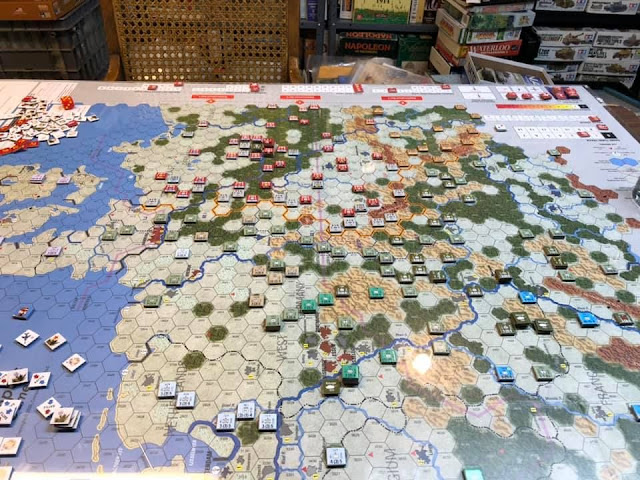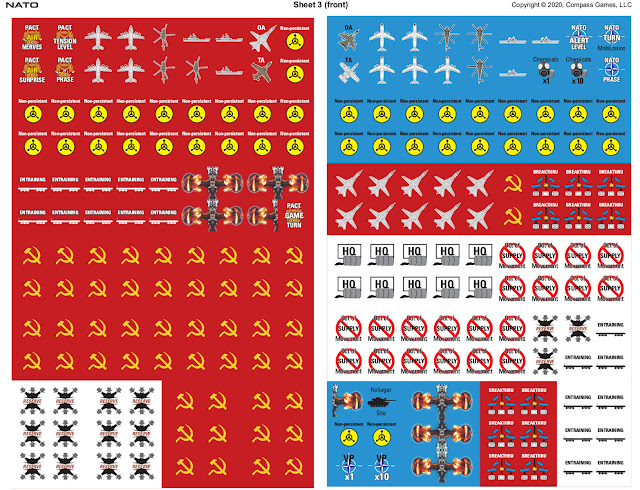Nato The Cold War Goes Hot
The Designer Signature Edition
by
Compass Games
"NATO, nukes, and Nazi's" are what sells wargames. This concise aphorism from the late 70s or early 80s has been attributed to a number of wargame designers. The original game was released in 1983 by Victory Games. By the amount of press and pieces in the magazines of the time, I would think that every wargamer at the time had a copy. I know I had one, in those halcyon days before I was seduced by computer wargames. Well, it has now been recreated in a new wonderfully looking edition by Compass Games.
Compass Games has been releasing some of the biggest games from the years of the last great board wargaming era. They are letting the original designers add or remove things from the games that they have been thinking about for the last forty-plus years. So, the gamer gets to have a fully revamped classic game that has also had all of the kinks, if there were any, worked out. This version has been printed with a lavishness that was not available at its first release.
The Cold War going hot was a very big topic in both reality and the wargaming community in the 1980s. Tensions had risen between the East and the West, and there were countless books and articles written about the strength of both sides.
This is the blurb about the game from Compass Games. I like to include them to show the gaming company's thoughts on the game. Then I can compare my thoughts on the game to theirs.
"NATO, Designer Signature Edition marks the return of a true wargaming classic by Bruce Maxwell. NATO simulates a potential NATO/Warsaw Pact conflict in Central Europe during the Cold War years of the 1980’s. First published in 1983, this game was Victory Games best-selling title, purchased by over 75,000 gamers worldwide. This new edition is based on an exhaustive two-year study by the Designer of the records that have come to light since the fall of the Berlin Wall. The game combines highly accurate information on the forces the Warsaw Pact actually had with now de-classified reports from the CIA and the Defense Intelligence Agency regarding what satellite surveillance and HUMINT revealed about their actual plans. The map has also been extensively updated with new satellite geography. Finally, the game system has been reworked to better reflect the fluid, fast paced and deadly nature of modern warfare, while retaining the original intention of simple and intuitive play. Here is the ultimate Cold War game, remastered, and playable in a single sitting.
NATO is a division/brigade level simulation of a Warsaw Pact invasion of Western Europe. The game map depicts the area from Denmark to the Swiss Alps, and from France to Poland. The time frame covers the first 14 days of war, after which one side or the other has usually run out of an army. The game offers four different Scenarios, covering 1) a surprise attack from a standing start, 2) an attempt by the WP to quietly prepare without tipping NATO off beforehand, 3) an extended buildup of forces by both sides before war breaks out, and 4) an introductory scenario covering the invasion of Denmark.
Scenario can be played with an Order of Battle from 1983, when NATO was still relatively weak, or with an Order of Battle from 1988, when NATO had rearmed and reorganized and was at the peak of its strength. The difference is impressive.
The game features infantry, armor, airborne and airmobile troops, marines, with easy mechanics to leverage combined arms operations. It also has extensive options for employing air power, chemical weapons and, for the truly desperate player, a last resort to nuclear weapons. The combat system is built around the concept that the best defense is a good offense, and features artillery, tactical and operational air strikes, reserves, counterattacks and deep exploitation, allowing for a rich set of tactical nuances in play. This is not a game where the WP attacks and NATO defends. Both players have to attack relentlessly if they want to defeat their opponent.
This Designer Signature edition of the classic Bruce Maxwell game has been upgraded with new units, new scenarios, new terrain, new tables and new player aid cards. Additional enhancements introduced in this edition include:
Super-sized components feature 9/16” counters and two game maps with larger hexes
Game map information has been updated and includes all-new map artwork
New units have been added, unit information has been updated and all units produced with new artwork
Existing scenarios have been updated and two new scenarios added
Orders of Battle are provided for all Scenarios both 1983 and 1988, allowing players to see the impact of the Reagan Era rearmament programs
The game system has been redesigned and the new rules include extensive illustrations, examples of play and Designer’s Notes to aid clarity
Each rules section now begins with a summary, allowing experienced players to skip many rules sections that embody classic game mechanics they already know
Rules details and restriction have been summarized graphically in Player Aids for faster reference and easier play
Enhanced ergonomics are provided for Scenario set up and Reinforcement charts
A new set of Designer’s Notes contain a wealth of historical information on what the West discovered after the Warsaw Pact collapsed and most of its members joined NATO."
 |
| The two maps together in all their glory |
Components:
One Rules Booklet
One Play Booklet with Scenarios & Designer’s Notes
Two 22″ x 34″ Maps
Four Counter Sheets (9/16″ size playing pieces)
One WP Player Charts & Tables Card
One NATO Player Charts & Tables Card
One WP Sequence of Play Card
One NATO Sequence of Play Card
One Warsaw Pact Strategic Surprise Reinforcement Schedule Card
One Warsaw Pact Extended Buildup Reinforcement Schedule Card
One NATO Strategic Surprise Reinforcement Schedule Card
One NATO Extended Buildup Reinforcement Schedule Card
Two 6-Sided Dice
One Game Box and Lid
 |
| The Strategic Surprise Scenario setup 1983 |
This is the breakdown of the game:
Complexity: 7 out of 10
Solitaire Suitability: 7 out of 10 (no hidden units)
Time Scale: 24 hours per turn
Map Scale: 15 miles per hex
Unit Scale: regiments, brigades, and divisions, abstract air and naval forces
Players: one to four, best with two
Playing Time: 3-8 hours depending upon scenario
 |
| All the Components laid out |
There you have what comes in the box. I am happy to report that Compass Games has hit one out of the park as far as the components of the game.
So, the game gives you the ability to play either the Warsaw Pact or NATO during this titanic class. One thing though, both sides were betting on a short, very short, war. The turn record track has only fourteen days in it. You read that right - fourteen! This might come as a shock to gamers who are used to the seemingly fast World War II pace, or the glacial pace of World War I and before. The designer makes his case on the fact of the almost total lethality of modern war. We are not talking nukes, but the lethality of regular munitions against each other. The dead pile of counters will show you the truth in this assumption. The Rhine River was only eighty-seven miles from the East German border. That would be less than six hexes at fifteen miles per hex. NATO had the thought that it had its back up against a wall, and it was quite correct in its assessment.
There are a few things about the original game that the designer, Bruce Maxwell, did not like. One of these was the tactical nuclear part of the game. Remember though, he has had almost forty years to work on the game. They spent another two years on the game before allowing Compass Games to reissue it.
NATO is one of those gems where a player has to take a long, long time to learn how to 'game' the rules and game. That is if you actually can do it. Each game plays out entirely differently than the next one. Each side is presented with so many choices. These are some of the weapons/strategies each can use:
Helicopters
Transport Movement/Interception
Air/Sea Ferry
Rail Movement
Supply/Resupply
Offensive/Defensive Strikes (Defensive Strikes are only used by NATO)
Chemical Warfare (The WP must initiate it)
Air Power/Air Strikes
Nuclear Strikes
As far as victory goes: The WP Player can win an Automatic Victory by having a Maneuver Unit (Not Airmobile, Airborne, or Marine Unit) in supply, west of the Rhine River and south of the Waal River. A NATO Automatic Victory can occur if they have been able to control two WP cities. The NATO Player can also get an Automatic Victory if he can relieve West Berlin or force Czechoslovakia to surrender. To relieve West Berlin the NATO Player must have a Maneuver Unit in Berlin with a Line of Supply to it. Each player must roll for the chance of causing 'Armageddon' when using nuclear weapons, with one caveat. The player who causes Armageddon loses automatically. Different levels of winning and losing are mostly defined by capturing and holding enemy cities. One very interesting rule is the 'Armistice' one. I do not think I remember a game having an actual rule for an armistice. Usually it is just something off the cuff by either player realizing he has lost. This game actually allows some structured give and take between each player.
 |
| Soviet Air Assets to the attack |
The scenarios are:
BALTAP Scenario (WP invasion of Denmark) This meant to be an introductory scenario.
Strategic Surprise Scenario
Extended Buildup Scenario
War of Nerves Scenario (This is where the WP player secretly tries to build up his forces before attacking)
There are OOBs and setup information for both the years 1983 and 1988. The year 1983 represents the low tide for US armaments. Where the year 1988 represents all of the buildup of the US Armed Forces under Reagan.
As I mentioned, I had bought the original game years ago. You have to understand that I had almost zero wargaming interest in a WP vs NATO game, except for maybe a 1945 or 1946 outbreak of World War III. So, for me to pick it up is definitely a salute to a game that so many other gamers were raving about. I really liked the original game. This iteration with all of its bells and whistles I cannot speak highly about. From the first-rate components to the obvious care, and dare I say love, that the designer and his team put into this new version is very apparent. Thank you very much Compass Games for sending this excellent game to review. I can recommend it to anyone who is interested in the era, or is just looking for a great wargaming experience. Below are the links to NATO and to Compass Games. Do yourself a favor and take a look at what else is in their stable.
Robert
NATO: The Cold War Goes Hot Designer Signature Series:
NATO, Designer Signature Edition – Compass Games
Compass Games:
Compass Games – New Directions In Gaming







0 comments :